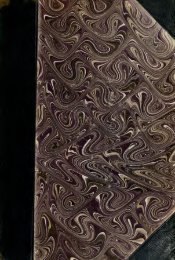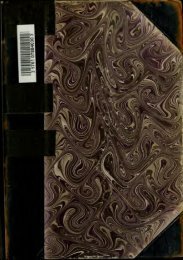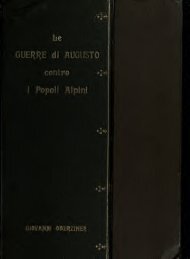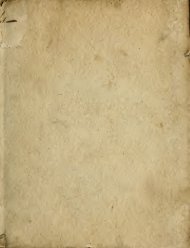Figurative uses of animal names in Latin and their ... - mura di tutti
Figurative uses of animal names in Latin and their ... - mura di tutti
Figurative uses of animal names in Latin and their ... - mura di tutti
You also want an ePaper? Increase the reach of your titles
YUMPU automatically turns print PDFs into web optimized ePapers that Google loves.
31<br />
had only two, <strong>and</strong> they were manipulated like the m<strong>and</strong>ibles<br />
<strong>of</strong> a crow; hence the figure.<br />
The Tyrian corvus was fashioned as a defensive eng<strong>in</strong>e,<br />
corvique et alia tuen<strong>di</strong>s urbibus excogitata praeparaban-<br />
^jjj.139 fQj. grasp<strong>in</strong>g <strong>and</strong> seiz<strong>in</strong>g.<br />
The corvus <strong>of</strong> Duilius, unlike that <strong>of</strong> the Tyrians, was<br />
<strong>di</strong>st<strong>in</strong>ctly <strong>of</strong>fensive. Its end was tipped with iron sharp-<br />
ened to a po<strong>in</strong>t, <strong>and</strong> shaped like a baker's pestle, as Poly-<br />
bius states : iirl he rov ireparo^ avrov (aruXov) •jrpoaijp/jLoa-To<br />
tnSrjpovv ohv virepov airw^a-fievov}*^<br />
The comparison with the pestle shows that the <strong>in</strong>strument<br />
is likened to a crow with closed m<strong>and</strong>ibles, to facilitate<br />
pierc<strong>in</strong>g. It was <strong>in</strong>tended, as Polybius goes on to say, to<br />
hold the ships together by forc<strong>in</strong>g its way through the deck,<br />
not by grappl<strong>in</strong>g : ore Se raw aavlari t&v KaTaarpc<strong>of</strong>iaTcov<br />
ip.ira'yevTei oi KopaKes <strong>of</strong>iov avvSi^a-aiev to? vaik.^*^<br />
As the corvus <strong>of</strong> Duilius resembled that <strong>of</strong> the Tyrians<br />
<strong>in</strong> name only <strong>and</strong> not <strong>in</strong> purpose or construction, Polybius<br />
is correct <strong>in</strong> his statement with regard to Duilius's <strong>in</strong>vention<br />
<strong>of</strong> a crow.<br />
Vitruvius speaks <strong>of</strong> a corvus demolitor,^*^ which evidently<br />
is identical with an eng<strong>in</strong>e that Vegetius describes, although<br />
the latter does not use the term corvus. The two descrip-<br />
tions are quite similar. Vegetius comments as follows<br />
trabem, quae adunco praefigitur ferro et falx vocatur ab eo,<br />
quod <strong>in</strong>curva est, ut de muro extrahat lapides.-'**<br />
Polybius's words are somewhat analogous : eirl he rov<br />
irepaTo^ avrov (trrtiXov) irpoaripfioaTo


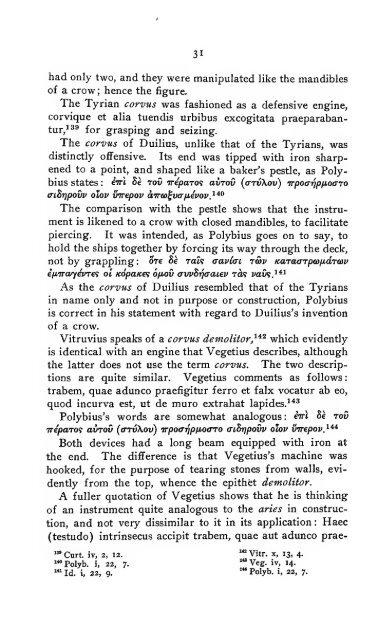
![Das Kriegswesen der Alten [microform] - mura di tutti](https://img.yumpu.com/21606999/1/167x260/das-kriegswesen-der-alten-microform-mura-di-tutti.jpg?quality=85)


